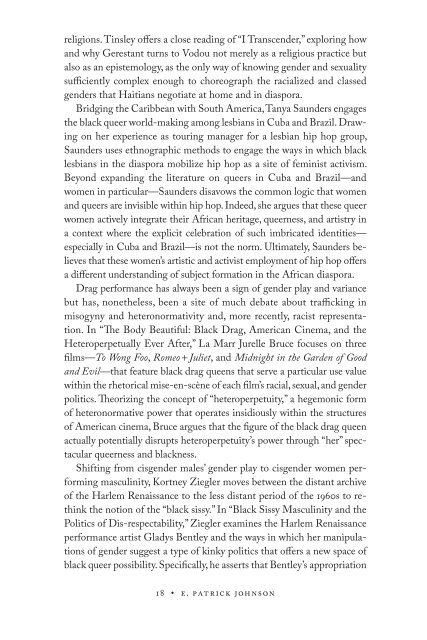No Tea
89AS6wvrf
89AS6wvrf
Create successful ePaper yourself
Turn your PDF publications into a flip-book with our unique Google optimized e-Paper software.
eligions. Tinsley offers a close reading of “I Transcender,” exploring how<br />
and why Gerestant turns to Vodou not merely as a religious practice but<br />
also as an epistemology, as the only way of knowing gender and sexuality<br />
sufficiently complex enough to choreograph the racialized and classed<br />
genders that Haitians negotiate at home and in diaspora.<br />
Bridging the Ca rib bean with South Amer i ca, Tanya Saunders engages<br />
the black queer world- making among lesbians in Cuba and Brazil. Drawing<br />
on her experience as touring man ag er for a lesbian hip hop group,<br />
Saunders uses ethnographic methods to engage the ways in which black<br />
lesbians in the diaspora mobilize hip hop as a site of feminist activism.<br />
Beyond expanding the lit er a ture on queers in Cuba and Brazil— and<br />
women in particular— Saunders disavows the common logic that women<br />
and queers are invisible within hip hop. Indeed, she argues that these queer<br />
women actively integrate their African heritage, queerness, and artistry in<br />
a context where the explicit cele bration of such imbricated identities—<br />
especially in Cuba and Brazil—is not the norm. Ultimately, Saunders believes<br />
that these women’s artistic and activist employment of hip hop offers<br />
a differ ent understanding of subject formation in the African diaspora.<br />
Drag per for mance has always been a sign of gender play and variance<br />
but has, nonetheless, been a site of much debate about trafficking in<br />
misogyny and heteronormativity and, more recently, racist repre sen tation.<br />
In “The Body Beautiful: Black Drag, American Cinema, and the<br />
Heteroperpetually Ever After,” La Marr Jurelle Bruce focuses on three<br />
films— To Wong Foo, Romeo + Juliet, and Midnight in the Garden of Good<br />
and Evil— that feature black drag queens that serve a par tic u lar use value<br />
within the rhetorical mise- en- scène of each film’s racial, sexual, and gender<br />
politics. Theorizing the concept of “heteroperpetuity,” a hegemonic form<br />
of heteronormative power that operates insidiously within the structures<br />
of American cinema, Bruce argues that the figure of the black drag queen<br />
actually potentially disrupts heteroperpetuity’s power through “her” spectacular<br />
queerness and blackness.<br />
Shifting from cisgender males’ gender play to cisgender women performing<br />
masculinity, Kortney Ziegler moves between the distant archive<br />
of the Harlem Re nais sance to the less distant period of the 1960s to rethink<br />
the notion of the “black sissy.” In “Black Sissy Masculinity and the<br />
Politics of Dis- respectability,” Ziegler examines the Harlem Re nais sance<br />
per for mance artist Gladys Bentley and the ways in which her manipulations<br />
of gender suggest a type of kinky politics that offers a new space of<br />
black queer possibility. Specifically, he asserts that Bentley’s appropriation<br />
18 • E. Patrick Johnson


